From the early 1970s to 1989, St. Sebastian Catholic Church in Chicago was a home for Catholic members of the LBGTQIA+ community. CHM curator of religion and community history Rebekah Coffman talks briefly about the church’s history, its place in the city’s LGBTQIA+ history, and the broader history of the Roman Catholic Church’s relationship with the LGBTQIA+ community.
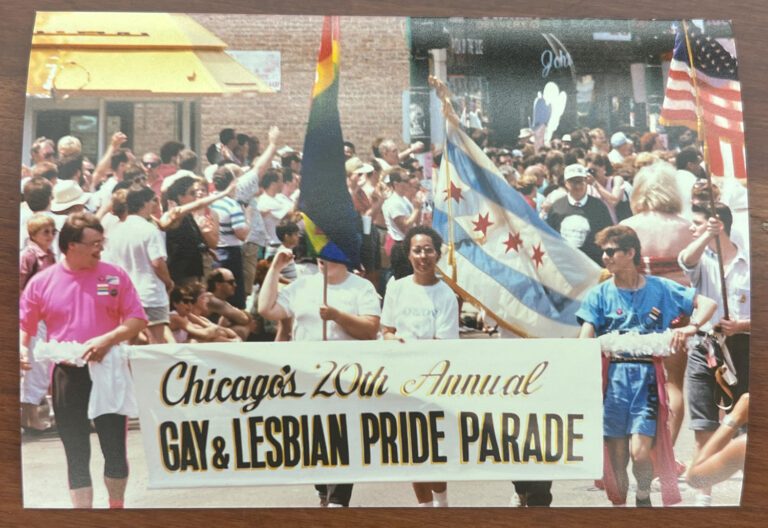
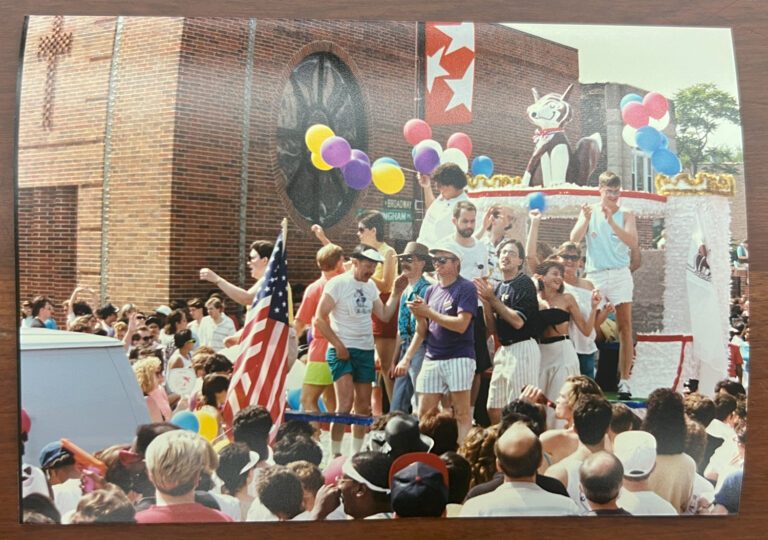
Images from the 20th Annual Pride Parade on Broadway Avenue in the Northalsted neighborhood, 1989, from CHM, Lee A. Newell II Visual Materials, 1997.0093, box 3.
For decades, Pride in Chicago has been affiliated with the North Side neighborhood of Northalsted, formerly known as Boystown, in the Lake View community area. The city’s first Pride parade was held in June 1970, one year after the Stonewall Uprising, and has become a principal annual recognition of LGBTQIA+ history and presence in Chicago. Parades also served as protest, asserting visibility and claiming the right to take up space in the public sphere.
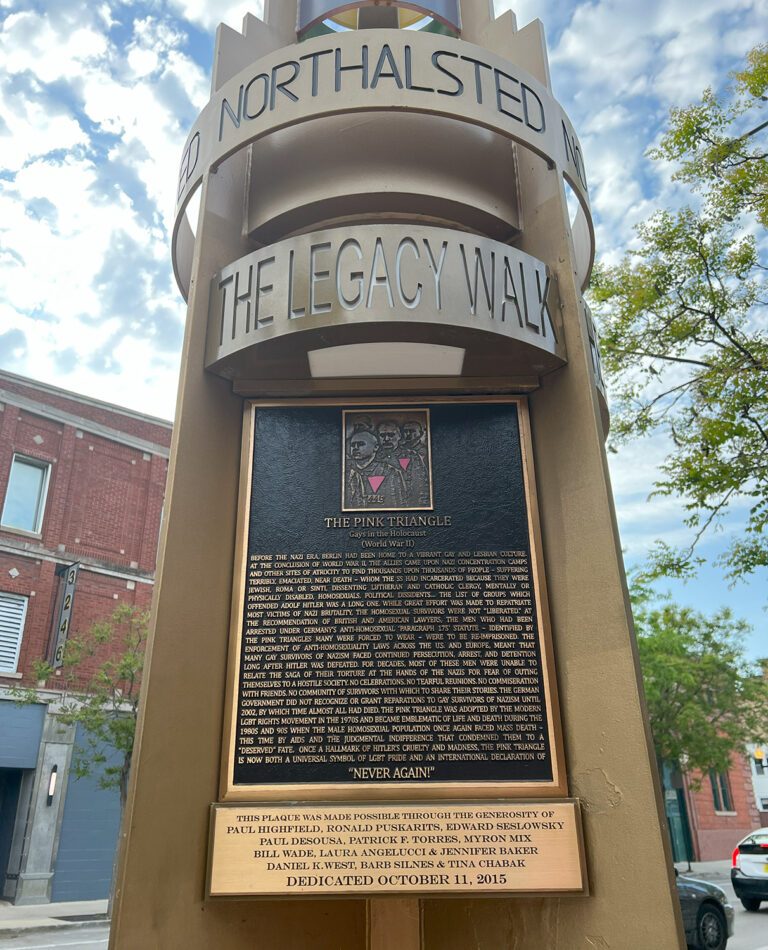
Stonewall marker on the Legacy Walk on North Halsted Avenue in the Lakeview community area. Photograph by Rebekah Coffman, 2022.
As Northalsted has continued to grow in its global recognition as an LGBTQIA+ inclusive neighborhood, so too has the commemoration of LGBTQIA+ histories. For example, the Legacy Walk on North Halsted Street, running between Belmont Avenue and Grace Street, is an outdoor museum consisting of a series of ten steel monuments memorializing biographical histories and legacies of LGBTQIA+ individuals around the world. Inaugurated in 2012, it was initially inspired through the Names Project AIDS Memorial Quilt in 1987. Each steel monument holds four bronze plaques, making 40 total, with new figures added annually. These monuments have made, and continue to make, LGBTQIA+ histories public that may otherwise be lesser known, hidden, or forgotten.
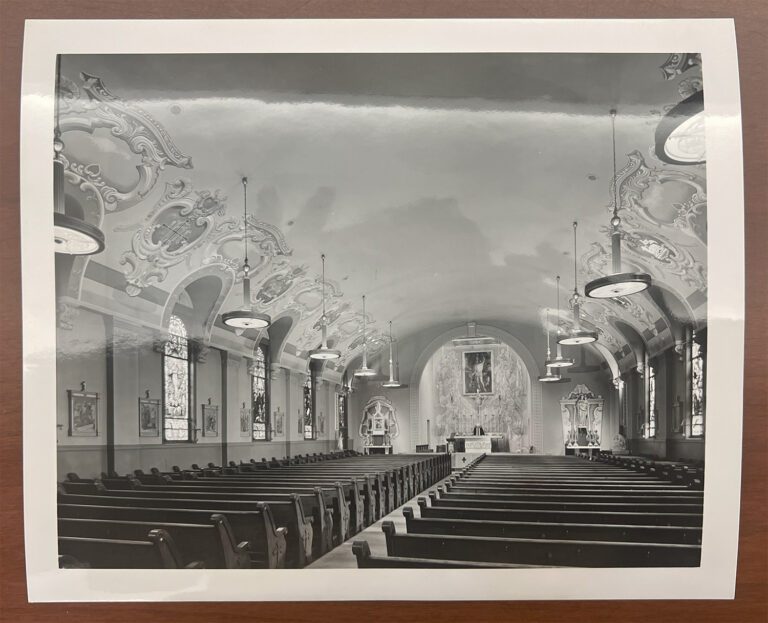
Interior view of St. Sebastian Church, August 31, 1953. Photograph by Hedrich-Blessing, CHM, HB-16434A
While more people may be familiar with these community markers and public displays, LGBTQIA+ history in Chicago is found in many lesser-known places around the city that do not have the same public memorialization. St. Sebastian Catholic Church is a story of one such lesser-known history.
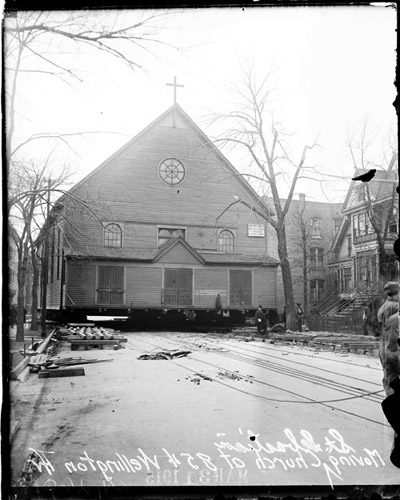
View of St. Sebastian Church being moved down West Wellington Avenue in the Lakeview community area of Chicago. March 15, 1915. DN-0064260, Chicago Daily News negatives collection, CHM.
The home of St. Sebastian Catholic Church was built as a simple wooden structure in 1886 on the corner of Wellington Avenue and Bucher Street (now Wilton Avenue), initially housing the congregation of Our Lady of Mount Carmel. In 1912, the congregation divided, and those who stayed at Wellington and Bucher became known as St. Sebastian’s, with Our Lady of Mount Carmel moving to a new chapel at Belmont Avenue and Clark Street. The physical structure of St. Sebastian’s was moved a couple of years later to the corner of Wellington Avenue and Dayton Street.
Over the next decades, St. Sebastian Catholic Church became known for serving a diverse body of worshippers, welcoming Polish, South American, Asian, and Puerto Rican churchgoers and holding a weekly Spanish mass. From the early 1970s to 1989, the church was an important place for the LGBTQIA+ community as the home to a weekly welcoming and affirming mass.
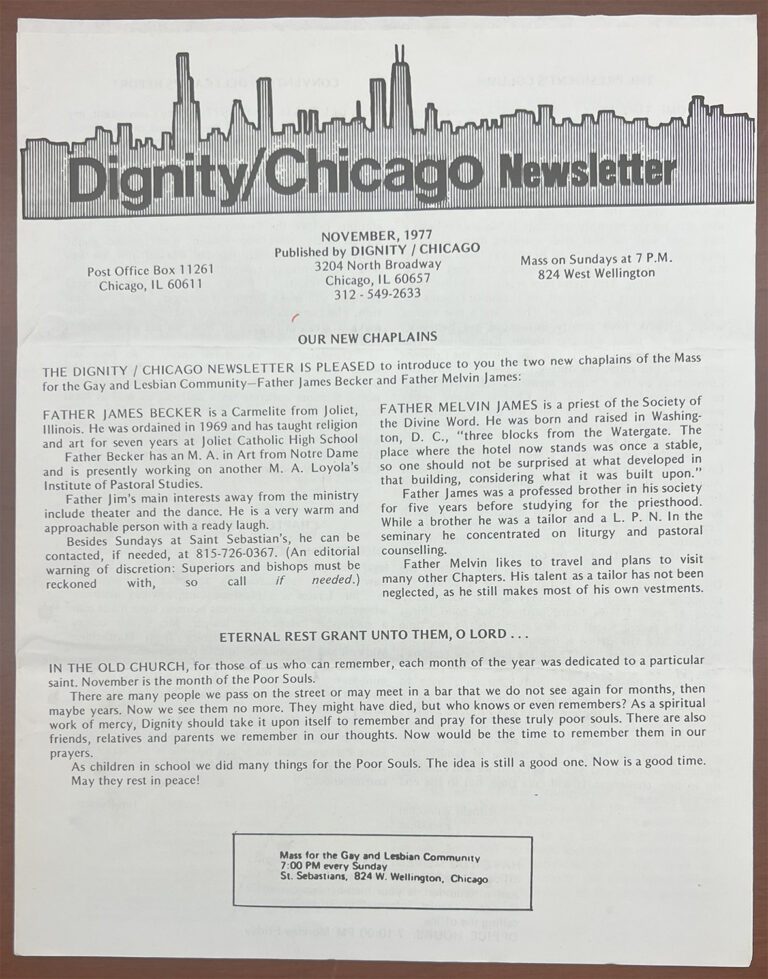
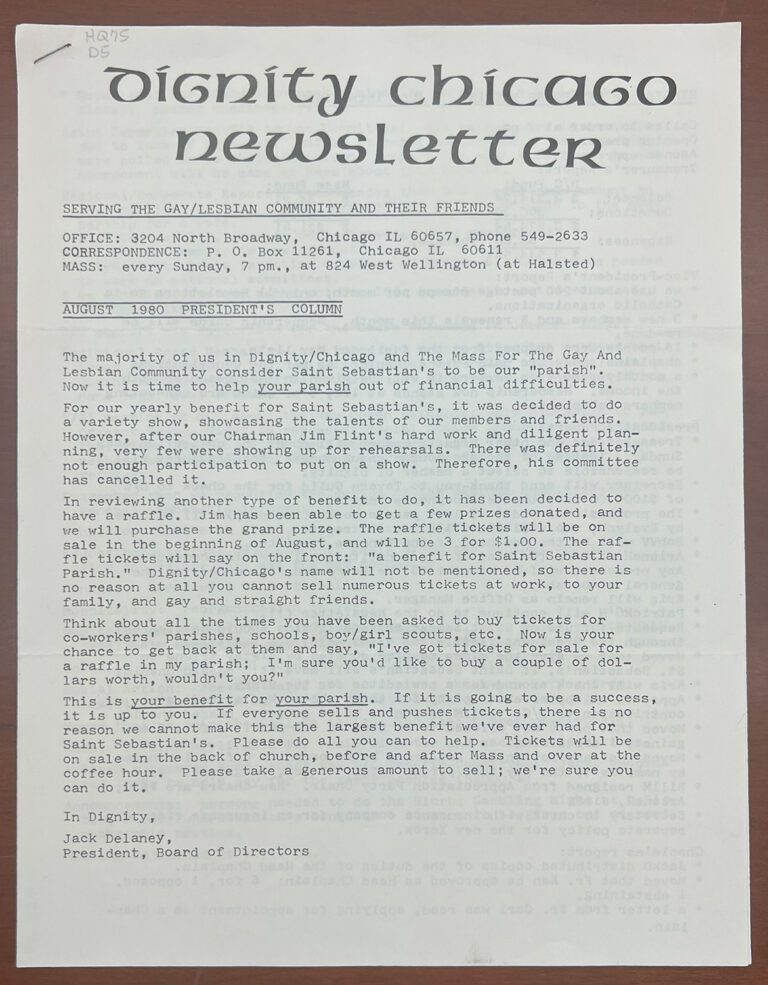
Dignity/Chicago newsletters, November 1977 and August 1980.
At this time, affirming masses at St. Sebastian’s were held on Sunday evenings and stewarded by an independent organization known as Dignity/Chicago. Formed in January 1972, Dignity/Chicago is a local chapter of DignityUSA, a national organization whose mission is “to work for respect and justice for all gay, lesbian, bisexual and transgender persons in the Catholic Church and the world.” It was founded to serve as a support for LGBTQIA+ Catholics, so they are “affirmed and experience dignity through the integration of their spirituality with their sexuality, and, as beloved persons of God, participate fully in all aspects of life within the Church and Society.” By the 1980s, the national organization had 110 chapters nationwide, and the local Chicago chapter grew to over 150 members.
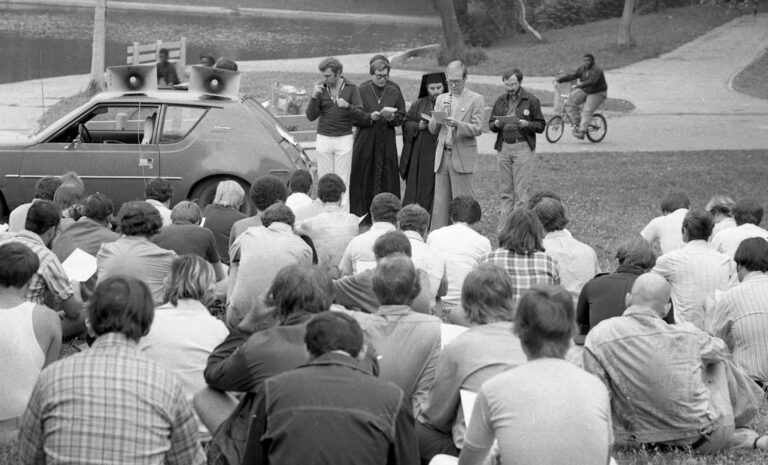
Religious service held in Lincoln Park as part of Pride week, June 22, 1977. ST-17300370-0009, Chicago Sun-Times collection, CHM
Despite this growing acceptance and presence in the Catholic church locally, the global church’s stance remained firmly positioned against full LGBTQIA+ inclusion. In 1986, the Vatican published a document titled On the Pastoral Care of Homosexual Persons, which sought to clarify the global Catholic Church’s position. While the directive claimed to affirm dignity for all people and permitted pastoral care to LGBTQIA+ people, it explicitly called homosexuality an “intrinsic moral evil,” instructing bishops to pull their support from organizations that contradicted the church’s official stance, including their use of Church buildings and facilities.
For some time following the edict’s pronouncement, Cardinal Joseph Bernardin permitted St. Sebastian’s priests to continue leading mass with Dignity. However, in May 1988 it was announced that services would be taken over by the archdiocese, with services led by pastors from five other churches who would lead “in accord with church teaching and discipline.” This approach had divisive results, with some saying they felt more supported by the Catholic church under diocesan leadership while others felt unwelcome.
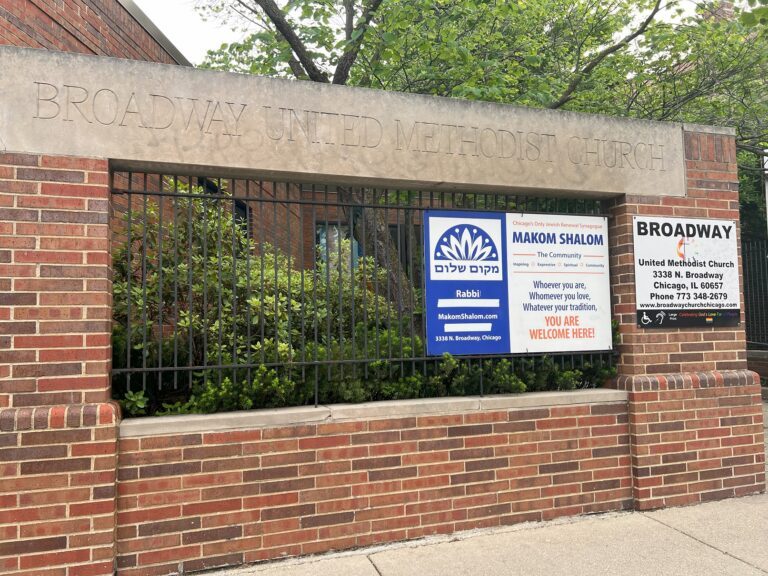
Broadway United Methodist Church in the Northalsted neighborhood. Photograph by Rebekah Coffman, 2022.
In May 1988, a majority of Dignity members voted to move their services to a non-Catholic facility and in June began worshipping at nearby Resurrection Lutheran Church. They would hold mass in several welcoming Protestant churches before finding a new permanent home at Broadway United Methodist Church in 1992.
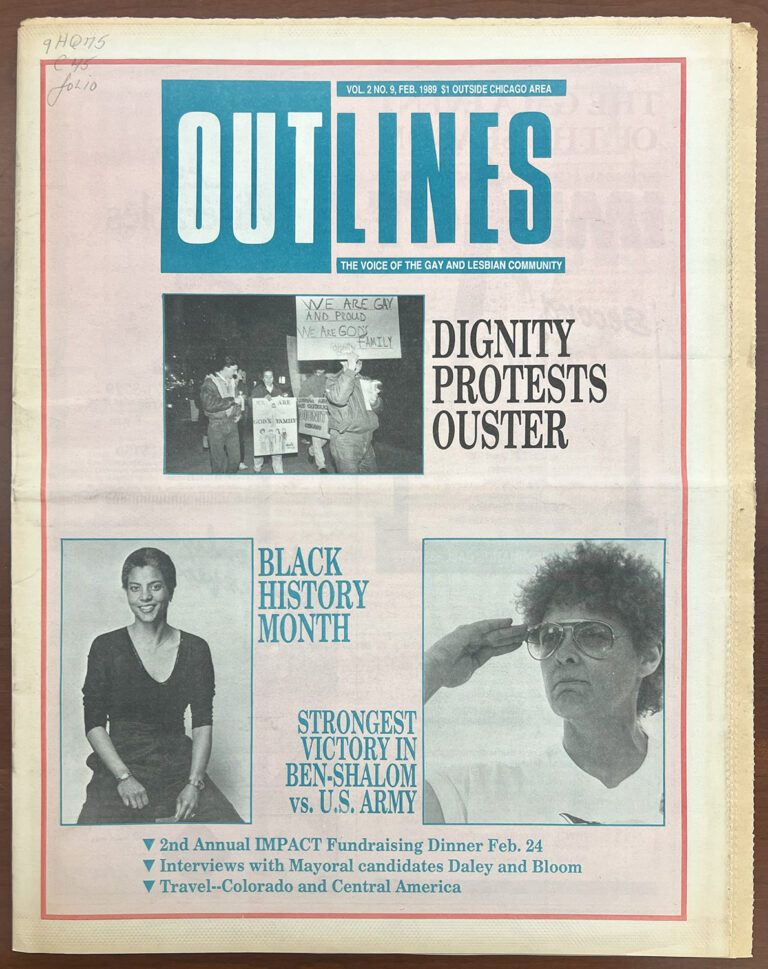
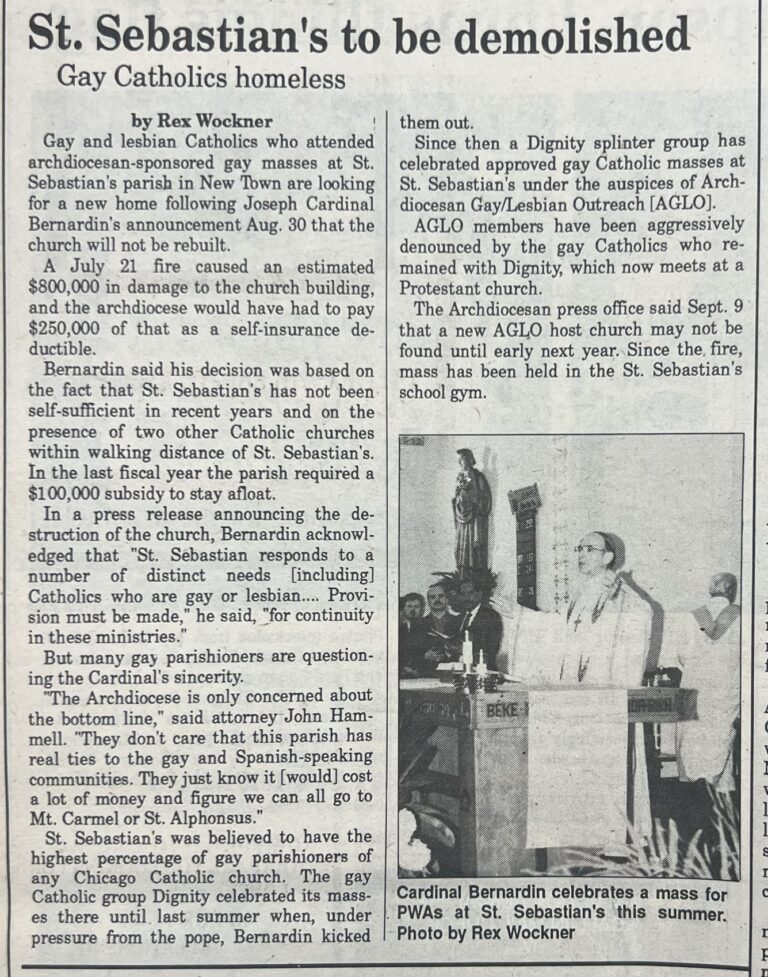
Outlines cover and detail from p. 16, February 1989. CHM, Outlines, HQ75.C45 Folio.
For LGBTQIA+ parishioners who chose to stay at St. Sebastian’s, through discussion with Cardinal Bernardin and LGBTQIA+ leaders, the affirming Sunday evening mass began to be led by the Archdiocesan Gay and Lesbian Outreach (AGLO), a ministry of the Catholic Church. However, by this time general attendance across all services at St. Sebastian’s—three English speaking, one Spanish speaking, and AGLO’s mass—was declining and financial challenges were growing. These issues compounded exponentially when a basement fire broke out in July 1989, creating hundreds of thousands of dollars’ worth of damage, essentially hollowing out the church building completely. The fire ultimately became the final straw in the congregation’s vitality and in December, Cardinal Bernardin announced St. Sebastian’s would not be rebuilt, closing officially on June 30, 1990.
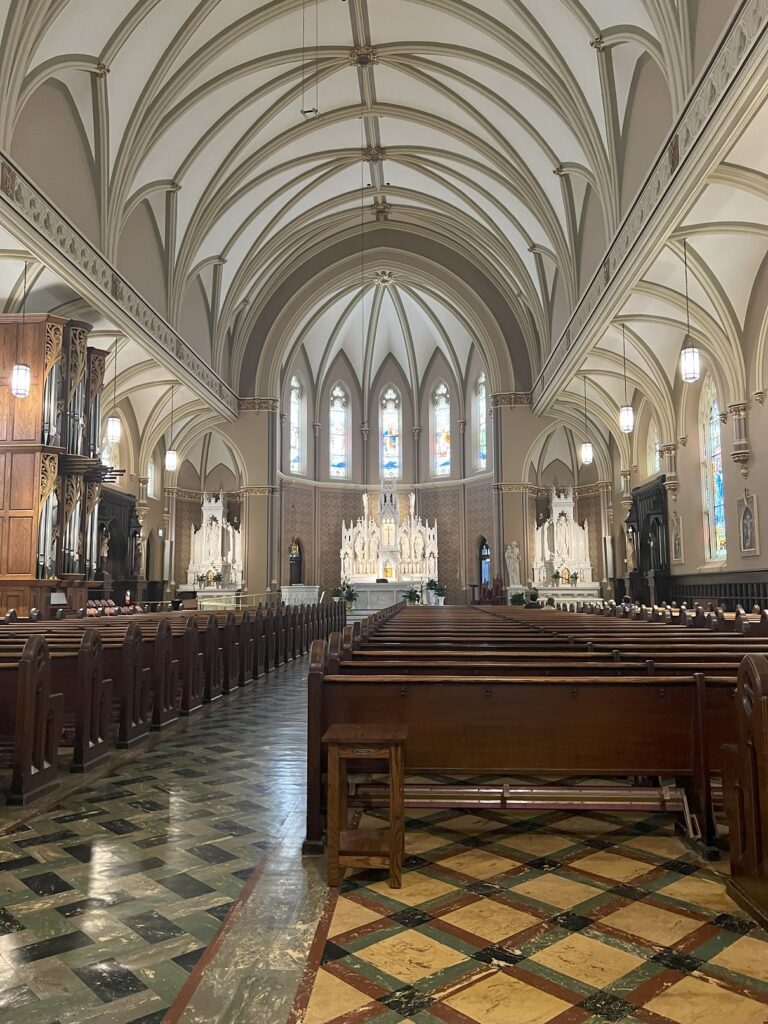
Sanctuary of Mount Carmel Catholic Church, Photograph by Rebekah Coffman, 2022.
Following St. Sebastian’s closure, surviving relics, church staff, and some parishioners moved to nearby Our Lady of Mount Carmel parish, which continues today as the “mother church” of AGLO. In a July 24, 1989, Chicago Tribune article titled “Parishioners keep faith after fire,” Juan Mosquera, a Cuban migrant who came to Chicago in 1962, is quoted saying, “The real church, the people—English, Spanish, gay—we are still here. We party together, we cry together.” Today, the global Roman Catholic Church still does not fully doctrinally affirm LGBTQIA+ people and lifestyles. However, recent shifts, such as Pope Francis’s authorization of blessing same-sex couples in December 2023, are evidence of the continuing legacy of decades of strives for full inclusion.



